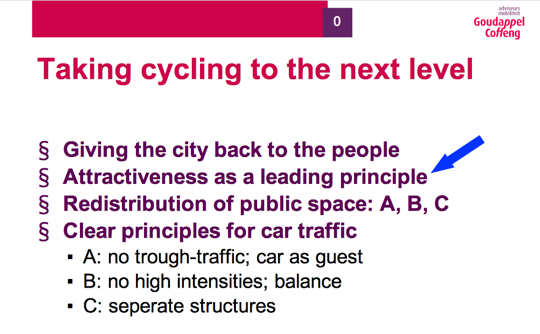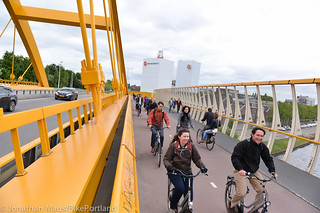Here in America, the most common word associated with new bikeway projects is “safety”. Deaths, injuries, and collision statistics are the key driver of which projects rise to the top of funding lists. Want a new bike path on a street in your neighborhood? The first thing PBOT will do is check the database for reported collisions along the route.
But what if all these discussion surrounding safety isn’t really where we should focus our energy? On the Green Lane Project blog this week, Michael Andersen (yes, that Michael Andersen) laid out the following case in a post titled, What if bike comfort is more important than bike safety?:
“What if bike [project] designers, instead of arguing about safety – an argument that, to be clear, I think protected bike lanes would win – decided that the most important measure of a good bikeway is whether people tend to like it?…
But when professionals make safety their only absolute value, they presume that physical safety is the most important value in people’s lives. And that assumption is demonstrably false. Of course people want safety. But they want other things, too.
A restaurant doesn’t measure its success by the percentage of people who dine there without getting sick. It measures success by the number of people who come in the door…”
Andersen’s perspective jibes with much of what a Portland delegation (which I was a part of) learned on a recent trip to the Netherlands (which was sponsored by the Green Lane Project). That is, “safety” as an engineering/organizing principle takes a back seat to many other attributes in the development of a successful bicycle network.
In fact, one of our guides on the trip, Tom Godefrooij of the Dutch Cycling Embassy, addressed this specific idea during a presentation he gave on our first day in Utrecht. Godefrooij explained that from the Dutch perspective, safety plays only a minor part in their approach to improving cycling. On this topic, he shared one of the most memorable quotes of our entire trip:
“Safety is not a goal of cycling policy, it’s a pre-condition.”
What Godefrooij was getting at is that the Dutch don’t sell cycling or cycling infrastructure by talking up safety benefits. There’s much more to it than that. “The challenge,” said Godefrooij, “Is to make cycling convenient and practical.”
In a slide, Godefrooij shared the four basic principles of bicycle planning in the Netherlands. On top of the list was “coherence of the network” (signage, and so on), then “directness” (minimizing delays and detours), then “attractiveness”, and at the bottom of the list was “safety”.
Furthering Godefrooij’s point was Bas Govers, a bicycle planning consultant with Goudappel Coffeng. He shared their work on the need for attractive roads that encourage cycling. In a survey of people doing errands by bike on a particular route in Utrecht, Govers said 82% chose a longer — yet more attractive — route for their trip. What’s most interesting however, is when asked about their choice, survey respondents actually thought the road was shorter. “Attractive roads shorten time awareness,” Govers said, “People think it’s faster, but it’s not.”
Given that, it should come as no surprise that when it comes to “Taking cycling to the next level” (the title of the Gover’s slide below), Govers doesn’t mention safety at all:

Perhaps a local example of this phenomenon is the Morrison Bridge. After waiting many years for bike access improvements, the County finally finished a $1.9 project in 2010. The new facility is definitely safer for bicycling, but it’s horrible from a connectivity standpoint and therefore it’s not an attractive cycle route. And the result? It has very low usage numbers and is therefore by some measure, a failed project.
Andersen’s blog post about safety and these examples from the Netherlands show quite clearly that there’s another, more appealing way to talk about and implement cycling infrastructure than always harping on safety.


